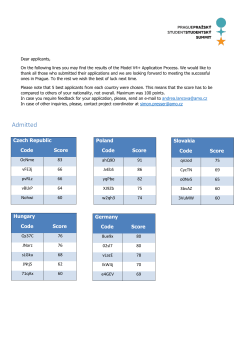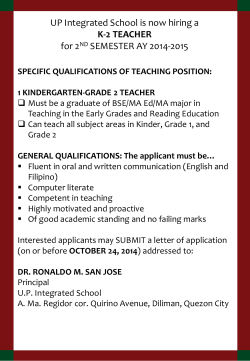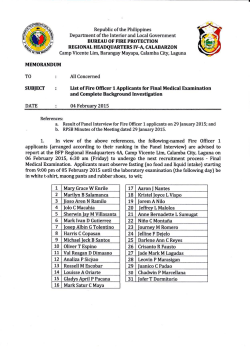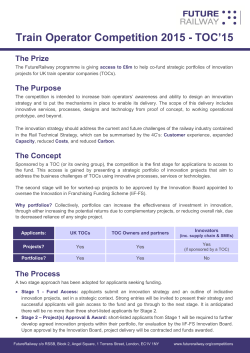
Occupational Therapy - Stellenbosch University!
PLEASE NOTE: This document is pending approval by the Senate of Stellenbosch University FACULTY OF MEDICINE AND HEALTH SCIENCES STELLENBOSCH UNIVERSITY GUIDELINES FOR THE SELECTION OF OCCUPATIONAL THERAPY STUDENTS IN THE ALLIED HEALTH SCIENCES (2015 for the 2016 intake) A. GENERAL INFORMATION 1. For admission to the B in Occupational Therapy degree programme an applicant shall hold the National Senior Certificate (NSC), endorsed by Umalusi with admission to Bachelors degree studies, or an equivalent qualification with an aggregate of at least 50% (level 4) (excluding Life Orientation) and at least 40% (level 3) for Mathematics, and at least 50% (level 4) for Life Sciences. Prospective students are strongly advised to include Physical Sciences and Afrikaans for the NSC. On account of the outstanding merit of most applicants, satisfying the minimum entrance requirements is by no means a guarantee for successful selection. 2. Since approximately 25-30% of the selected applicants do not accept the selection offer, more applicants are selected initially and eventually reach the goal of more or less 50 in total. 3. Two places at the most are reserved for applicants who are admitted at the request of the Rector on account of extraordinary considerations (as determined by the Rector him-/herself). These numbers are in addition to the above numbers. 4. The annual revision of the number of students admitted to the programme depends on: - Training capacity in terms of human resources, infrastructure and the clinical training platform. Regional and national needs. Enrolment planning of the University 5. Only applicants who have indicated B in Occupational Therapy as a first choice on their application will be considered. 6. Candidates cannot transfer their selection from one year to another. If an applicant is successful, but does not take up his/her selection, such an applicant will normally have to apply anew to be considered for selection in future. 7. As soon as the final National Senior Certificate marks (or equivalent) become available in January of the following year, these marks and/or the improved NBT Occupational Therapy Selection Guidelines (2015 for the 2016 intake) 1 results are used instead of the Grade 11 marks and the original NBT results respectively, and the waiting list order is adjusted accordingly. B. GUIDELINES FOR THE SELECTION OF OCCUPATIONAL THERAPY STUDENTS Applicants are considered in the three different categories as set out below. B1. B2. B3. Current learners (grade 12) and applicants who have completed school (pg 2 – 3) Registered students (pg 3 – 5) Applicants with tertiary qualifications and/or work experience (pg 5) 1. CURRENT LEARNERS (GRADE 12) AND APPLICANTS WHO HAVE COMPLETED SCHOOL 1.1 Selection of this group takes place at the first selection opportunity during the second semester of the preceding year. 1.2 Applicants who had matriculated longer than three year ago, cannot be considered within this category and it is recommended that they prepare themselves to be considered within category B2 or B3. Please note that selection within these categories can still not be guaranteed. 1.3 Applicants within this category (+ 37 places) are selected on the basis of academic as well as non-academic merit: 1.3.1 Academic merit, which constitutes 45% of the selection factor. 1.3.1.1 In the case of Grade 12 learners, the average academic percentage obtained in the final Grade 11 year-end examination is used. 1.3.1.2 In the case of applicants who have completed school, the average academic percentage obtained in the National Senior Certificate (NSC) Examination or equivalent is used. 1.3.2 National Benchmark Tests (NBT), which comprises 30% of the selection factor. The average percentage obtained in the tests will be used. 1.3.3 Non-academic merit, which constitutes 25% of the selection factor. 1.3.3.1 The non-academic merit mark is calculated on the basis of the following scale. Information is gathered by means of a structured questionnaire. The accuracy of the information must be verified by the school principal. The onus rests upon the applicant, as well as the school principal, to ensure that the information is complete and correct. INFORMATION WITH REGARD TO * Leadership MAXIMUM MARK 5 Occupational Therapy Selection Guidelines (2015 for the 2016 intake) 2 * * * * * * * * Community service Cultural activities Sport Other extraordinary achievements Language proficiency Association with SU (parents/sibling(s) are alumni/ current students or staff) Rural origin Part-time or after-hours employment 4 4 4 4 3 2 4 1 1.3.3.2 The score for each of the items is the maximum possible score. The marks are calculated according to specific and consistent criteria. Only achievements during the last 3 years at high school level are taken into consideration. 1.3.3.3 No additions or changes may be made to the non-academic merit form once it has reached the selection office. The only exceptions being marks obtained after the form has been dispatched and only if verified by the school principal, provided that the selection office receives the form not later than the end of June of the relevant year. 1.4 The selection factor is calculated by adding up the academic and non-academic merit marks, as well as the NBT average in a 45:30:25 ratio. All applicants are then placed on a merit list according to their selection factor, which forms the basis for the selection of these students. 1.5 The selection process takes place as follows: 1.5.1 The top 17 applicants are selected in priority sequence according to the selection factor, irrespective of country of origin, race or any other considerations. 1.5.2 Then all black, coloured and Indian applicants who qualify, will be selected until all the available places have been filled. Applicants who obtain an average percentage between 50 and 54.9% may be considered for the mainstream programme, if they passed at least 2 of the NBT tests on the proficient level. 1.5.3 Qualifying foreign nationals will also be chosen and considered on merit. 1.5.4 If there is still space available in the programme after all coloured, Indian and black applicants have been selected, applicants are then selected according to order of priority until all spaces have been filled. 1.5.5 When all the available places are filled, approximately 30 of the remaining applicants who qualify are put on the waiting list, as follows: The order is determined by the calculated selection factor. As soon as the final National Senior Certificate marks (or equivalent) become available, these are used instead of the Grade 11 marks and the waiting list order is adjusted accordingly. Cancellations are replaced from the waiting list according to merit based on the selection factor, provided that there is place in the programme. Occupational Therapy Selection Guidelines (2015 for the 2016 intake) 3 1.5.6 The applications of initially unsuccessful applicants, who have earned significantly higher marks in the National Senior Certificate examination (or equivalent) and meet the minimum admission requirements, and/or who have improved their NBT results, will be reconsidered in January of the following year. These applicants will then be considered together with the applicants on the original waiting list, and the newly calculated selection factor will determine the order of ranking on the waiting list. 2. REGISTERED STUDENTS 2.1 Approximately 10 of the places are filled from this group. 2.2 The majority of these places are reserved for students of this university who follow suitable fields of study (preferably related to the natural or social sciences). 2.3 The following registered students are collectively considered in this category: Undergraduate Bachelor’s students (see 2.4 and 2.5 for exception) Honours students Final-year Master’s students Doctoral students completing their doctoral studies in the year in which they have applied No pre-determined number exists for any of the above-mentioned groupings. 2.4 Registered students who follow another selection programme in Health Sciences at the SU will not be considered. 2.5 Registered students who follow another selection programme in Health Sciences at another university will not be considered for selection. 2.6 A student wanting a transfer from an Occupational Therapy programme at another university to the Bachelor of Occupational Therapy at this University will be considered by the Programme Committee. Such transfers will only be granted in highly exceptional cases. 2.7 The selection process takes place as follows: This group is selected on the basis of academic performance, as well as a few other considerations (see 2.8): Academic merit The average academic performance of registered students is determined by calculating the weighted average performance of all the years of study together. 2.8 The following additional guidelines also apply to this category of applicants: Occupational Therapy Selection Guidelines (2015 for the 2016 intake) 4 2.8.1 Applications from current students who will complete their degree in the relevant year, or other students (mainly BSc students) who pass all their subjects over the specific number of years, will be considered. 2.8.2 In the case of students who complete the degree in the year concerned, preference will be given to students who complete the degree in the prescribed time, no fail comments appear on the record, and with a weighted average of at least 60% for the duration of the programme. In the case of other students, preference will be given to students who pass all their subjects with a weighted average of at least 60% over the specific number of years. 2.8.3 In the case of post graduate students, undergraduate performance is also considered. 2.8.4 Students who are selected for B in Occupational Therapy I could be exempted from corresponding modules which they have passed, according to certain criteria, but all the modules from which they are not exempted must be passed in order for them to be promoted to Occupational Therapy II the following year. 2.9 Registered SU students’ applications are considered in early December, after the final results have become available. Students who do not make use of the first examination opportunity, cannot be considered. 2.10 Applications for admission from students of other universities are considered in January of the following year, after their final results have been received. 2.11 Students are ranged in order of priority on the basis of the preceding considerations, and this serves as point of departure for the selection process. All registered students, both undergraduate and postgraduate, compete jointly for these places. Special consideration may be given to black, Indian and coloured students who meet the minimum requirements described in 2.8.2. 2.12 When all the available places are filled, qualifying applicants are placed on a waiting list according to academic merit. Cancellations are filled from the waiting list according to academic merit, provided that there is place in the programme. 3. APPLICANTS WITH TERTIARY QUALIFICATIONS AND/OR WORK EXPERIENCE 3.1 Selection of this group of applicants takes place at the first selection opportunity during the second semester of the preceding year. 3.2 Approximately 6 places will be reserved for persons with tertiary qualifications and/or work experience, and who are not enrolled for a further qualification at the time of application. 3.3 Candidates who have a tertiary qualification(s), as well as work experience, and who are registered for single modules at tertiary level for non-degree purposes at the time of application, may also be considered within this category. Occupational Therapy Selection Guidelines (2015 for the 2016 intake) 5 3.4 Preference will be given to applicants who have already obtained a degree or degrees in the normal time and with a weighted average of 60% or more and who have included a motivational letter with the application. 3.5 Although these applicants are selected according to academic, as well as nonacademic merit, they are not selected according to the same formula as that used for current learners. A shortlist of meritorious applicants is then compiled after the consideration of all applications within this category. 3.6 A final selection of applicants on the shortlist will be made after a personal interview. 3.7 Invitation to an interview is by no means a guarantee that an applicant will be selected. C. SELECTION OF APPLICANTS 1. The Faculty of Medicine and Health Sciences, in consultation with the Vice-Rector (Learning and Teaching), annually determines enrolment targets that are aligned with, inter alia, the guidelines of the National Department of Higher Education and Training for the transformation of the higher education sector and the subsequent institutional enrolment planning, as well as the University’s commitment to inclusivity and diversity. 2. In the case of current learners, the selection factor is calculated according to the same formula as described in B1. It is taken into account that selection will not be based solely on the 45:30:25 formula, as some applicants may not have had all the opportunities for non-academic achievements. 3. Black, Indian and coloured students who do not meet the minimum admission requirements may still be admitted to the programme on the basis of a good performance in the NBT and at the discretion of the Faculty Board. D. TAKING THE NATIONAL BENCHMARK TESTS (NBT) INDIAN, COLOURED AND BLACK 1. All current learners or applicants who have completed school (B1), who apply for admission to B in Occupational Therapy, irrespective of the percentage or total they obtained in the Grade 11 or 12 examinations, must take the NBT. The average percentage of these tests counts toward 30% of the selection factor. 2. The tests will be conducted countrywide at various centres. 3. Prospective Health Sciences students must write the NBT before the closing date which is determined annually (see www.maties.com) by registering (at least 3 weeks before the test date) at www.nbt.ac.za to secure a place at the relevant venue. Occupational Therapy Selection Guidelines (2015 for the 2016 intake) 6 4. Prospective students must write all tests on the same day. 5. If an applicant makes use of more than one opportunity to write the NBT during the same year, the results available by the end of July will be considered for selection in the second semester; the NBT results available by the end of December will be used in January in conjunction with the NSC results for selection from the waiting list. 6. Registered university students (B2) and applicants with tertiary qualifications and/or work experience (B3) are exempted from this requirement. E. FOREIGN NATIONALS Applications from foreign nationals will be considered on merit. F. PROCEDURES TO BE FOLLOWED FOR THE SELECTION PROCESS 1. APPLICATION FORMS 1.1 Applicants can apply electronically at www.maties.com 1.2 The closing date for submitting applications, including the non-academic merit questionnaire, for consideration during the initial selection process, is 30 June of the year that precedes registration. 2. PROCESSING OF APPLICATIONS 2.1 A complete database of each applicant is compiled based on the information captured by the applicant on the online application form. At the same time, the current learners’ or applicants who have completed schools’ (B1) marks are processed electronically. 2.2 The questionnaires on non-academic merit are checked and the marks are calculated as indicated in B.1.2.3. The marks are also captured and, together with the school marks, as well as the average of the NBT marks, are processed on computer in order to determine the final selection factor. (The selection factor is used to determine an applicant’s position on the merit list). 2.3 The academic records of registered students (B2) as well as those of graduates (B3), are processed by hand and an average percentage is calculated. These students are then considered on the basis of academic performance, although non-academic merit may also be taken into consideration in the case of graduates (B3). 2.4 It is expected of applicants to provide an undertaking that all information provided is accurate. In the event that it should be discovered that a selected applicant has provided false information or has withheld information, he/she might forfeit their selection. Occupational Therapy Selection Guidelines (2015 for the 2016 intake) 7 3. SELECTION OPPORTUNITIES 3.1 The first selection takes place during the second semester of the previous year. On this occasion current learners and applicants who have completed school (B1), as well as applicants with post-school experience and/or post-school qualifications (B3) are considered. The selection of the latter applicants (who are put on a short list) is only finalised after interviews with members of the Selection Committee (see B3.3.3 and B3.3.4). The applications of registered students (B2) are only considered after their final university results have become available (in December in the case of SU students or in January in the case of students from other universities). 3.2 3.3 Scimathus students are considered in January in the same category as applicants who have completed school (on the basis of their new selection factor). 3.4 Further selection from the waiting list takes place continuously, depending on cancellations received and available places in the programme. 3.5 Selection is finalised two weeks after the commencement of the first semester classes for Occupational Therapy I. 4. SENDING OUT SELECTION LETTERS 4.1 After the selection meetings, applicants are informed in writing of the selection results. 4.2 Selected applicants must respond within 4 weeks from mailing the selection letters, stating whether or not they accept the offer. 4.3 If they accept the selection offer, the prescribed selection deposit is due. The amount will be to the student’s credit. Applicants who accept their selection offer, pay the prescribed selection deposit and afterwards cancel their selection of their own accord, will not be refunded their selection deposit. 4.4 The places of applicants who do not respond to the offer and cannot be reached administratively, will be cancelled. 5. APPLICANTS WHO NO LONGER MEET THE ADMISSION REQUIREMENTS AFTER THE FINAL NATIONAL SENIOR CERTIFICATE RESULTS HAVE BECOME AVAILABLE 5.1 Applicants who obtained provisional acceptance during the first selection round and who do not meet the minimum requirements with their final matric results, will forfeit their selection and the selection deposit will be refunded. 5.2 The applications of black, Indian and coloured applicants who forfeit their selection can be reconsidered at the discretion of the Faculty Board on condition that satisfactory results were obtained in the NBT. Occupational Therapy Selection Guidelines (2015 for the 2016 intake) 8 G. COMPOSITION OF THE SELECTION COMMITTEE The Selection Committee comprises the following members: The Executive Head: Interdisciplinary Health Sciences (Chairperson) The Dean, Faculty of Medicine and Health Sciences The Deputy Dean (Education), Faculty of Medicine and Health Sciences The Deputy Dean (Community Service and Interaction), Faculty of Medicine and Health Sciences The Head of Division: Occupational Therapy The Head of Division: Speech-Language and Hearing Therapy The Head of Division: Human Nutrition The Head of Division: Physiotherapy One member of the MB,ChB Selection Committee, appointed by this committee. March 2015 Occupational Therapy Selection Guidelines (2015 for the 2016 intake) 9
© Copyright 2025









